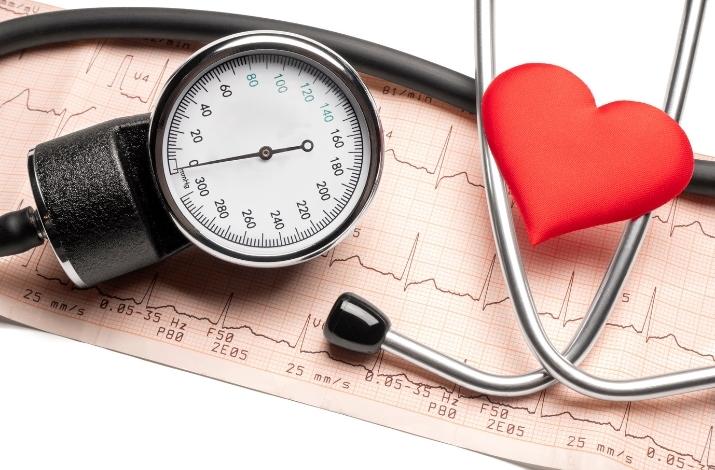Worried About High Blood Pressure? Try This!

Every time you go to the doctor’s office, they wrap a cuff on your arm and inflate it until it’s uncomfortable. Of course, this isn’t a torture device, but rather a simple device to check your blood pressure. Checking blood pressure is a routine (and very inexpensive) measurement that can be very informative. For many years, high blood pressure was not considered a health problem. In fact, President Franklin D. Roosevelt was given a clean bill of health even though his blood pressure was 220/120 mm Hg (which is very high). He died of a stroke two months later in 1945.
“Essential hypertension” was a term coined around this time because high blood pressure was (and still is) so common among the elderly that it was considered unavoidable, and a normal, healthy part of aging. Thankfully, we’ve become wiser over the years and now recognize that strokes, heart attacks, cardiovascular disease, peripheral arterial disease, abdominal aortic aneurysm, and a shorter lifespan can all stem from the “silent killer” of increased blood pressure.[1]
What is blood pressure?
With a blood pressure measurement, you’ll see two numbers. For example, 132/85. The top number is called the “systolic” blood pressure which represents the amount of force your blood is putting on your arteries when the heart is pumping. The bottom number is called the “diastolic” blood pressure and represents the amount of force your blood is putting on your arteries when the heart is at rest.
Stress and pressure on your arteries can be good if it’s the right kind of stress. Shear stress, for example, is the measurement of the force your blood puts on the lining of your blood vessels as it passes by. When this stress is smooth and consistent (as found in healthy blood vessels) it helps prevent coagulation and helps the blood vessels react appropriately under stress. When this stress is turbulent or inconsistent (as found in blood vessels with atherosclerosis) the blood vessels thicken and don’t respond appropriately.[2] At the end of the day, you want a healthy blood pressure that flows smoothly.
What is a healthy blood pressure?
Until recently, a blood pressure of 120/80 was considered ideal. However, the most recent recommendations suggest that an optimal systolic blood pressure be less than 120 and an optimal diastolic blood pressure be less than 80. If your blood pressure ranges around 130/85, you’re considered to be on the high end of normal, and if your blood pressure is 150/90 or higher, it is generally recommended to intervene with lifestyle changes and/or medications.[3] Many adults live their lives with blood pressures much higher than this, and practitioners are encouraged to be more vigilant about getting their patients’ blood pressures down.
How can I decrease my blood pressure?
If your physician told you that you have high blood pressure, they would likely follow standard medical practices to help you get back on track. This would include weight loss, reduced sodium (salt) intake, reduced alcohol intake, increased physical activity, and a handful of medications that get rid of fluid and force your blood vessels to relax and open.[4] Each of these will help reduce blood pressure, and I would encourage you to approach your blood pressure with as many lifestyle interventions as possible.
A less-likely scenario would be for your physician to ask you to cut back on insulin-spiking foods. While cutting salt and relaxing your arteries will reduce your blood pressure, these approaches only tackle part of the problem. If you look at your diet, you’ll likely find that you do eat a lot of sodium, but you’ll also find that the foods you eat send your insulin higher than a kite. Insulin is a strong stimulant for salt retention in the kidneys, and where salt goes, water follows. High insulin = lots of salt retention = high blood pressure.[5]
So, it’s not wrong to cut back on salt, but the sodium in your soda isn’t the only thing causing high blood pressure, those refined sugars are playing a big role too.
I do not practice medicine or have a medical license, so I cannot give medical advice. What I do know is that it would be worth having a conversation with your healthcare provider to see if it’s appropriate and safe for you to reduce your insulin through your lifestyle choices. Three of my favorite options for keeping insulin (and blood pressure) low include regular fasting, regular physical activity, and eating a diet that is low in carbohydrates, particularly refined sugars.
While a single lifestyle intervention of reducing insulin may not completely change your blood pressure, the cumulative effects of healthy choices will make all the difference in how you look, feel, and function. Take small steps each day to improve and you’ll be amazed at the long-term results.
References
- Rapsomaniki E, Timmis A, George J, et al. Blood pressure and incidence of twelve cardiovascular diseases: lifetime risks, healthy life-years lost, and age-specific associations in 1.25 million people. Lancet. 2014;383(9932):1899-1911.
- Paszkowiak JJ, Dardik A. Arterial wall shear stress: observations from the bench to the bedside. Vasc Endovascular Surg. 2003;37(1):47-57.
- Armstrong C. JNC 8 Guidelines for the Management of Hypertension in Adults. Am Fam Physician. 2014;90(7):503-504.
- Ferdinand KC, Vo TN, Echols MR. State-of-the-Art review: Hypertension practice guidelines in the era of COVID-19. Am J Prev Cardiol. 2020;2:100038.
- 5. Pliquett RU, Fuhrer D, Falk S, Zysset S, von Cramon DY, Stumvoll M. The effects of insulin on the central nervous system – Focus on appetite regulation. Hormone and Metabolic Research. 2006;38(7):442-446.
This article is for informational and educational purposes only. It is not, nor is it intended to be substitute for professional medical advice, diagnosis, or treatment and should never be relied upon for specific medical advice.


















